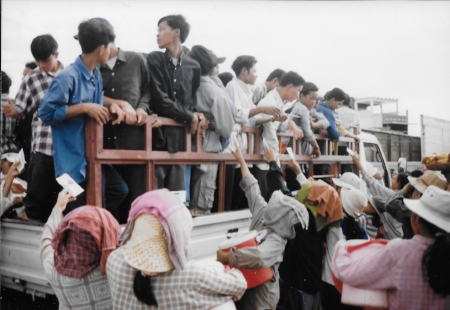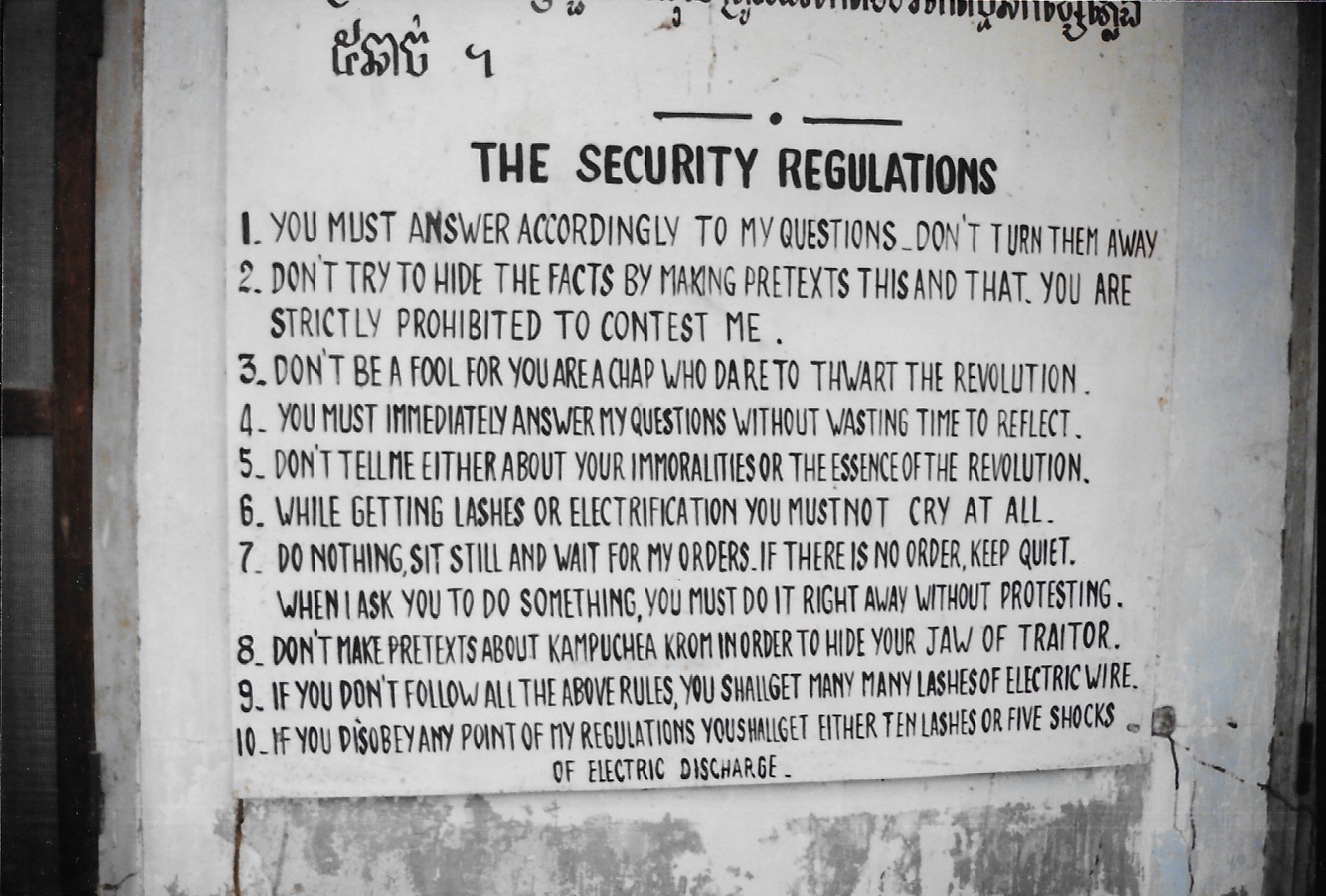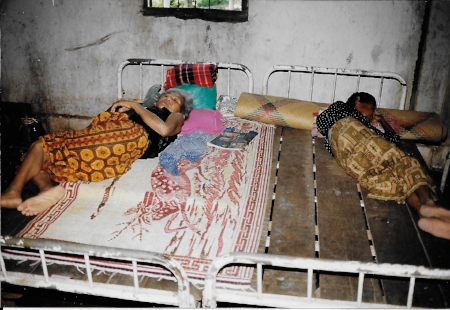Phnom Penh, Cambodia: Saturday, November 13, 1999: I was up at 4:30 a.m. Pitou, Sally, and I were going to try to cram everything we’d planned for Friday, Saturday, and Sunday into one day. I grabbed a little breakfast at 5:30 a.m. My stomach just wouldn’t respond positively to the thought of chicken-giblet porridge, so I settled for a pot of hot green tea and some good french bread with jam. Pitou and Sally wanted me to meet their team, so we arranged to take a thirteen-hour road trip together.
On our way out of town, we picked up Yim Youdavann, the government ministry lady who went with us on Wednesday to Takeo and to Angkor Chey. Sally’s brother, Sam Victor Thong, from Long Beach, California, also joined us. He escaped to the US with Pitou and Sally in 1975 and returned to Cambodia for the first time a year ago. He decided to join Sally and Pitou to help improve the lives of his countrymen.
As was explained before, Sally and Pitou’s experience with the Khmer Rouge wasn’t quite as traumatic as Setan’s and Randa’s. They were both in Thailand when Pol Pot and the Khmer Rouge took over the country, so they traveled directly from Thailand to the United States, where they were given political asylum in California. They lost everything and were separated for many years from family members, but Pitou was able to find employment as a civil engineer in Long Beach right away and was employed with the same department for twenty-five years before he retired with honor. They both became US citizens and returned to Phnom Penh for a visit in 1989. Both agreed that one day they would return to help the rural people of Cambodia. They both accepted Christ at a church in Long Beach and are now wonderful Christians. It was interesting to see that now other members of their family, like Sam Thong, are joining them in their efforts to help the Cambodian people.
The doctor who is a friend of Pitou’s and went with us to assess the military hospital in Phnom Penh, accompanied us today. His name is Dr. Hai Loewy Kauv, and he is part of Pitou’s medical team. Rounding out the team are Sary Som from the ministry of interior; Bun Thoeun Sao, a safety officer with the police department; and Chhoeuy Meas, a teacher at a Phnom Penh high school. The team goes by the name CMC (Cambodian Methodist Council).
Three other men, all of whom are Koreans, work with Pitou and Sally but aren’t part of the CMC team. Pitou and Sally refer to them as their Tapioca Team. Jay Shin is a professional tapioca buyer; Nam Pyo Hong lived in Hanoi, Vietnam, for fifteen years and is currently an overseer at a factory in Phnom Penh; and Se Ha Yoo represents a bulk-commodities shipping company in Phnom Penh, SK Shipping, where he works as the general manager.
One of Pitou’s projects is to coordinate contracts between tapioca farmers and buyers. He gets buyers to sign a purchase contract and then gets rural farmers who have already agreed to work together to sign a contract to grow the tapioca. In the past, after the farmers had grown the crop and harvested it, the buyers would either cut the price so drastically at harvest time that no money could be made from the sale, or sometimes the buyers didn’t even show up to take the crop, and the farmers were left with spoiled tapioca and no money for the year’s efforts. Pitou’s plan to coordinate the production and sale of the tapioca should benefit everyone in the deal.
The Tapioca Team was joining us today to get acquainted with Project C.U.R.E. and view some of the tapioca farms.
There were too many of us for one van, so Pitou hired another van and driver. Our route took us south and east out of Phnom Penh toward Vietnam through the province of Kandal. Once out of the heart of Phnom Penh, it didn’t take us long to run into more Grand Canyon roads. The motorcycles were actually traveling much faster than we were because they could more easily swerve around the washouts and huge potholes.
About 11:00 a.m., one of the van’s engines threw off a fan belt from the water pump and generator. The diesel engine quickly overheated, and the driver was forced to pull to the side of the road. Spare parts aren’t readily available in rural Cambodia, so we were stuck. Sally had brought along some steamed rice and meat, and we had plenty of drinking water, so about fifteen of us sat alongside the country road and had an early lunch.
Then the team members fanned out and went in search of a properly fitting fan belt. Since I didn’t know how to say, “Fan belt for Mitsubishi van” in Cambodian, I stayed with the vehicle.
About two hours later, a belt was located, and all the male helpers managed to repair the problem. But when the driver tried to start the engine, he found that a couple of the valves were sticking because the engine had overheated, and the van wouldn’t even pull its own weight, let alone all the passengers.
From that point on in the journey, we all got real friendly and cozy and very well acquainted. All fourteen of us, plus the driver, piled into one van, and we proceeded on our thirteen-hour journey. I forgot to add that there was no air-conditioning in the van.
When we arrived in the town of Neak Leung, we waited to cross by ferry over the Mekong River. We picked a national-holiday weekend for our trip, so hundreds of people were packed in the backs of trucks and trailers headed for other towns to visit family and friends. The ferryboats were crossing the wide river as fast as possible, and the town was crowded with vendors selling their steamed shrimp, roasted bananas, cooked chickens, fruits, cakes, fried breads, and Coca-Cola. The vendors carried big platters on their heads and sold to the hungry people in the trucks waiting to cross the river.
The three men from Korea all speak very good English. They asked some leading questions about Project C.U.R.E., and I, without blushing or shame, took outright advantage of their captivity inside the van. I told them all about the eighty countries into which we are shipping donated medical supplies and equipment, and how we procure and distribute the goods.
Then they asked the leading question. “Well, Dr. Jackson, if you don’t receive any salary for what you’re doing, why do you leave your home and travel all over the world to do it?”
Bingo!
I started telling my story from the very beginning about the change God brought about in my life, and the fact that I’m the happiest man in the world. They just sat in shock and said nothing. I decided to interrupt the quiet time and tell them that I needed them to help me. I needed Se Ha Yoo, the shipping man, to introduce me to people in the industry who could start shipping containers around the world at no cost for Project C.U.R.E.
I suggested that Mr. Shin and Mr. Hong find organizations, industrialists, and businessmen to get involved in helping us finance the operation of Project C.U.R.E. The slow, hot, crowded ride wasn’t turning out so badly after all.
From the ferryboat crossing at Neak Leung, we headed almost straight north to the city of Prey Veng. About thirty minutes out of Prey Veng, a rural area with about four thousand families and no health-care facility, the Tapioca Team agreed that if Pitou can secure the supplies and equipment, they will build a nice clinic. The health ministry has already agreed to staff the venture if the facility is available.
After viewing two alternative sites for the new clinic in Prey Veng, we continued our trip northward to the province of Kampong Cham via the city of Chup. As we headed west at Chup, we traveled through miles of land where the jungle had been cleared years ago, and rubber trees were planted. The trees are very mature now and have probably been producing rubber for a long time.
Once again we ran into the giant Mekong River meandering its way through the country to the South China Sea. At the town of Tonlé Bet, we waited in line in the hot sun for a ferryboat to take us to the west side of the river.
During our time together, individual team members wanted to talk about Project C.U.R.E. and my strange story of giving away my accumulated wealth to follow God’s leading. I could tell that the story bothered them.
The shipping manager said, “How could you possibly do that? I spend every minute of my time trying to earn money for myself.”
My response was simple, “And just what do you plan to do with it all when that’s all you have and nothing else?”
By that time darkness had fallen in the jungle and over the rice paddies, but vivid memories were stuck in my head. In my mind as I closed my eyes, I could still see against the blue Cambodian sky, the silhouettes of thousands of simple thatched- and tin-roofed houses built on stilts. I could still see families sitting in their covered-table areas close to the road as they entertained family members and neighbors. Some rural family members hand-thrashed the stalks of rice by beating the rice heads against a slanted board, which caught the rice and directed it to the ground. I could still see the big black water buffalo wallowing in the harvested rice fields and munching on the stubble.
In my mind were pictures of old women spreading the rice on mats alongside the road so that the breeze from passing cars and trucks would blow away the chaff. I could see literally thousands of small Cambodian children swimming and diving in the muddy water in the rivers and ditches. And of course, I could still see countless motorcycles streaming past me, and the many miles of pothole-ridden roads built on top of the rice-field dikes.
To be able to be in Cambodia mingling with the people, not as a tourist, but as someone who has come to help them in their time of need, is an inexpressible privilege. For some reason, God has placed a deep love and concern way down inside of me for the hurting people in his universe. I never dreamed I would fall in love with the Asian people, who have so many needs and whose lives are so complex.
The cities of Vat Nokor and Skuon rushed by in the darkness, and off in the distance, I could see the lights of Phnom Penh. I’m happy and thankful that I followed through with the last-minute plans to travel to Cambodia. Maybe I will return someday, or maybe I will just live with vivid memories locked inside my head. But by being obedient and traveling to Cambodia, something has been set into action, and once Project C.U.R.E. containers start finding their way into this country, the health-care system and the lives of hurting, needy people will never be the same. On this dark Cambodian night, I wonder what the future will hold in this exciting, ongoing adventure.
Next Week: Trying to draw lines between the dots so that I will never forget Cambodia



























